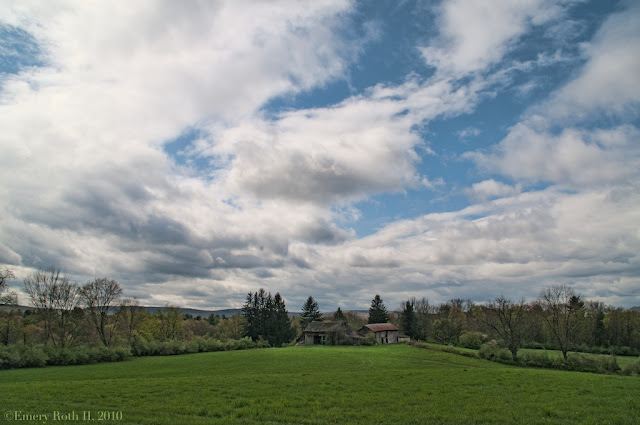EXHIBITION OPENING SATURDAY, 11:00 AM to 1:00 PM, Gunn Memorial Library: Click here for info.
HOUSATONIC TIMES ARTICLE: Click here.
PHOTOGRAPHER'S JOURNAL: The road that crossed Main Street at the crossroads in the woods outside Walpack was just a narrow, cinder, forest road. I followed it in both directions later in my visit. It parallels the main valley road but on the east side of the valley. Along it are occasional farmsteads, homesteads and isolated houses, all abandoned. Many of the barns were large with hand-hewn beams and pegged bracing, the careful work of early, local craftsmen. The roofs were gone in all and hay loft floors were often rotting. The previous two images were of a farmstead along this road. The barns in this photo were on a different road but similarly fated.
Most of the abandoned houses were old. One fine homestead of stone dated to the 18th century, but there was also a yellow wreck of a raised ranch right out of 1950s suburbia. One wall had fallen away so I could look in, but one look at the outside, and I knew how the rooms lay. Beyond the fallen wall was a row of white, metal, enameled kitchen counters and cabinets, and I could see through a door into the living room where the floor had decayed, and there was a hole into the garage below, and the ceiling above was similarly compromised. Behind the wreckage I could see the mahogony stair railing and a staircase still ascending to the second floor, balusters and banisters still polished.
In the front of the house I could make out the rebellious remains of what had once been formal shrubbery. I climbed a bit of the hill behind the house to see if there was shot back down. To my surprise, nestled in the brush and hugging the vanished yard was an in-ground swimming pool filled with a dark, soupy brew; the pool was about to be swallowed by encroaching forest. What young family had abandoned this woodland paradise?
From time to time throughout the day I did see other people, mostly fishermen, but they didn't allay my sense that I had strayed from my proper century and was haunting someone else's. The fisherman were, after all, visitors like me, but unlike me, they stayed close to Flatbrook and never conversed with the natives. Near the end of the day it was a relief when my friend, Gary, joined me shooting at this abandoned barn not far from the crafts center. When visiting another century, it's safer to go with friends.
skip to main |
skip to sidebar
Subscribe
I've been making photographs since childhood. Photography has become a way for me to explore the place I live and places I visit, but I know there's much to be seen in my own back yard. My favorite travel is through time.
This blog is a discipline and challenge to myself. However, I always welcome hearing how these posts touch those who visit.
COPYRIGHT
I like to share, but please contact me for permission to download, print, or use my photos or original writings. All are copyrighted.
Photo Pages
TODAY'S PAGES
You can see my work exhibited at
Blog Archive
- ► 2015 (102)
- ► 2014 (145)
- ► 2013 (135)
- ► 2012 (150)
- ► 2011 (138)
- ▼ 2010 (148)
- ► 2009 (177)
- ► 2008 (185)
My Books
Favorite Photo Links
- Lenscapes Photo Field Trips & Services
- Davro-Digital Gallery
- The Camera's Eye
- Deborah Mends/Atelier Mends
- Walking the Boroughs
- Gary's Smugmug Site
- Wassaic Project
- Hart & Soul
- In Soul
- A Photo a Day from Planet Earth
- Tao of Digital Photography
- Martin Kimmeldorf's Pixel Playground
- Ivan Goldberg Photo Web Site
- Steve McCurry Photo Web Site
- Petphotoart's Photos
- Brad Smith: Monochromes
- Karin Smith: Painting with a Camera
- Martha My Dear's Photos
- Faces of Macricostas Exhibit
- The Daily Photo









6 comments:
http://www.youtube.com/watch?v=Q7RPCFfudmU
One of my favorites!
Really! I'm delighted and surprised.
My grandparents had a farm near the Flatbrook, outside of Peter's Valley, which was then known as Bevans. Their historic 1700s farmhouse was not "abandoned", but instead was taken by the government through eminent domain, in order to create the park and public land that now exists. For a while, the gov't rented the house out to craftspeople, but then the gov't stopped renting it out and let it fall apart.
Sorry, Stewox, I didn't mean to suggest the people abandoned the houses, but the government. Your description of what generally happened is exactly what I learned and meant to convey, except that the purpose was to create the reservoir. THe park plan was initially only a small detail. When the dam idea was finally scrapped, the park became the whole thing.
I'm glad you found the site, and I hope you enjoyed the blog entries. In some ways I guess you may have comfort that this beautiful land that your family was a part of is preserved.
I'd love to learn more of what you know of Peters Valley.
It seems most people is leaving the countryside; it emerges as «paysage» only...
People leaving the countryside?
Post a Comment